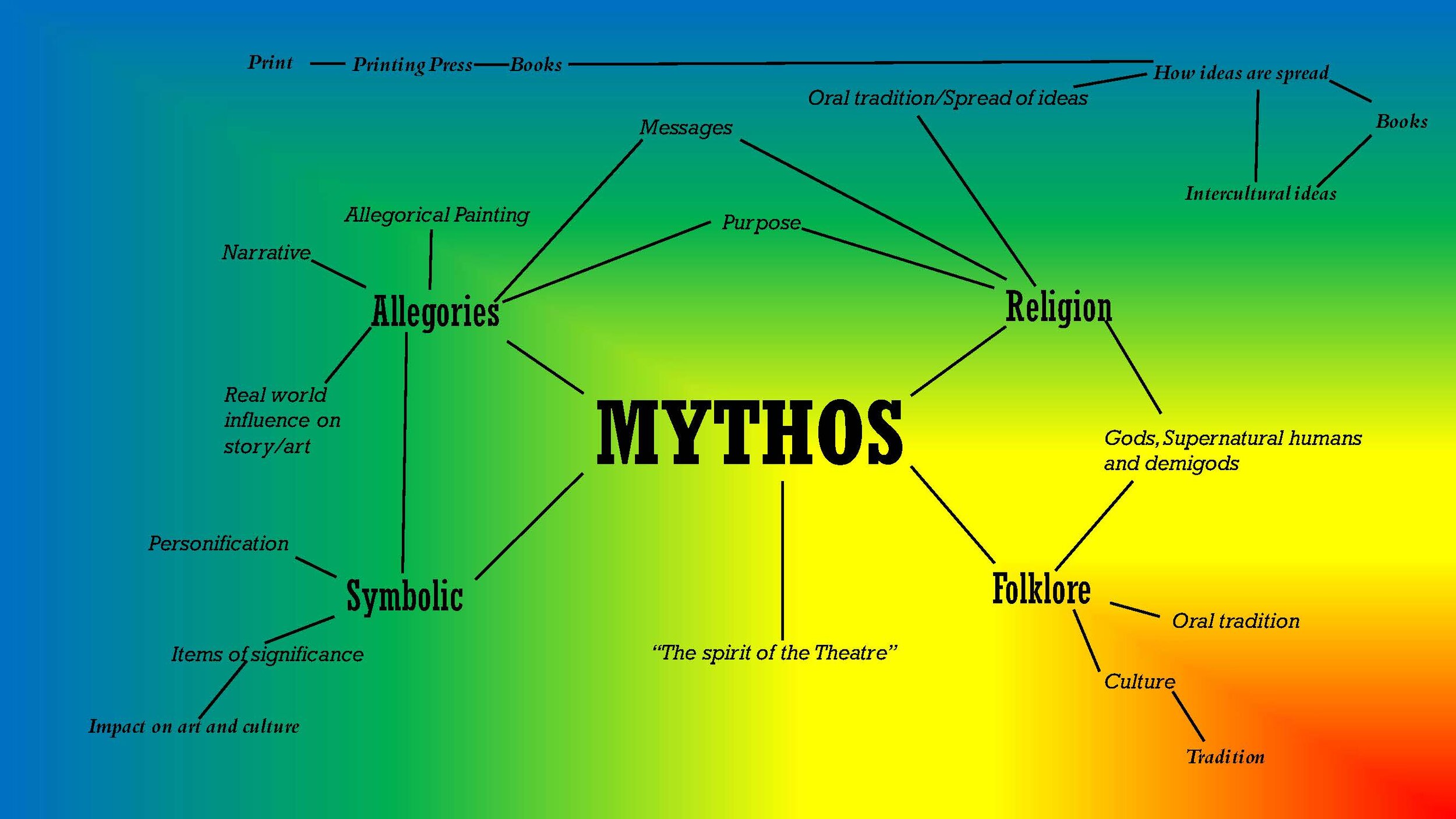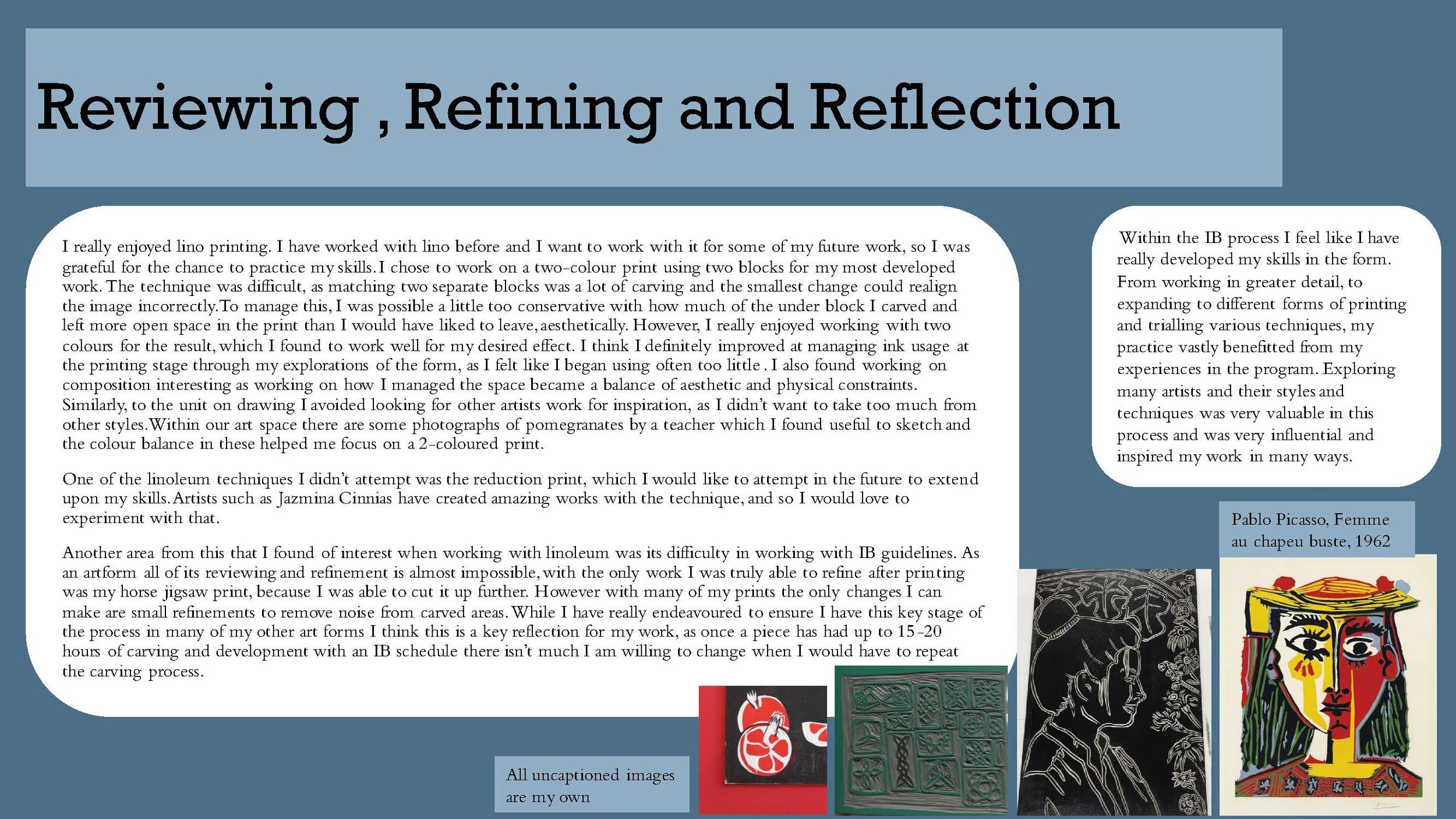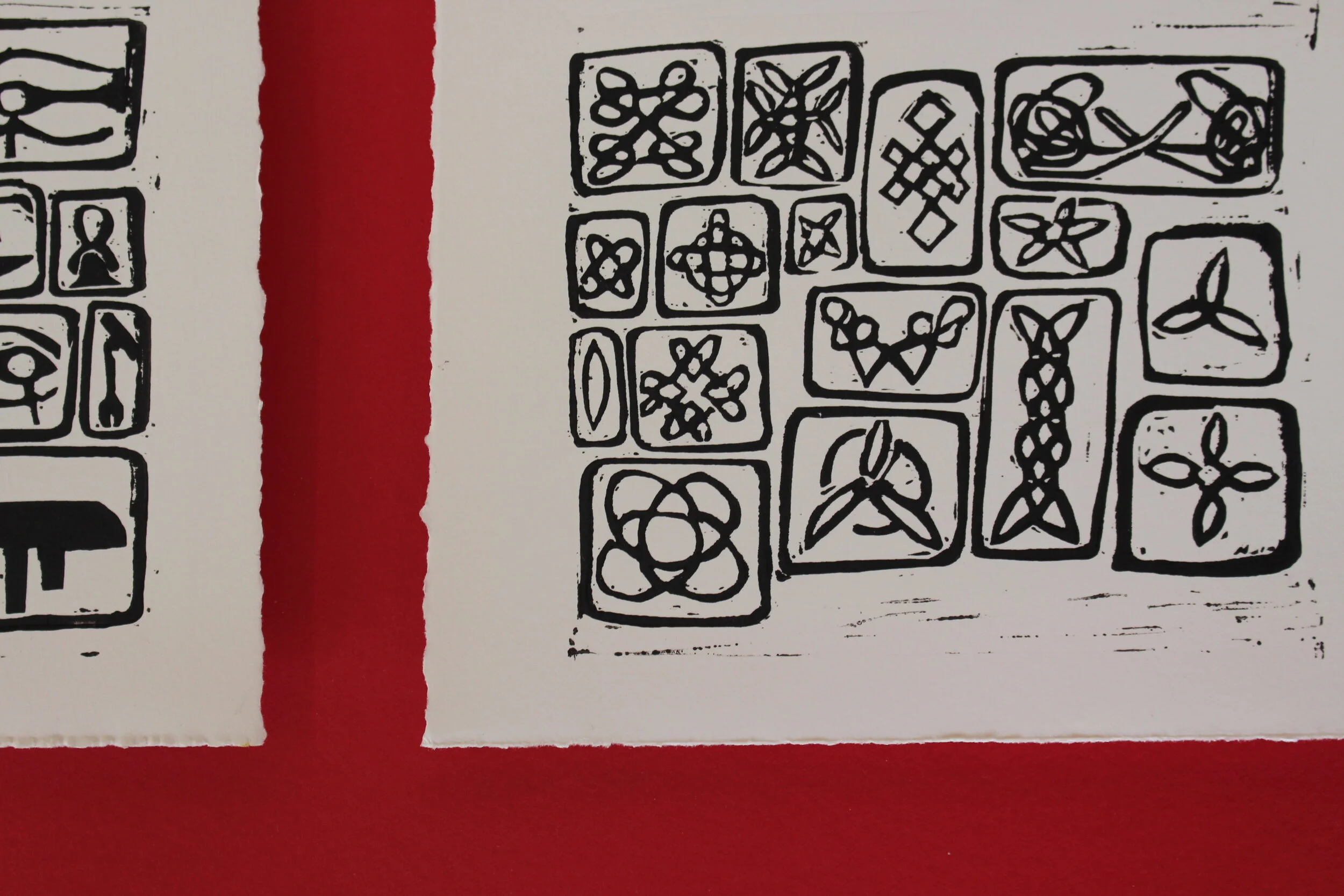ib visual arts
jemima adams
I have always had a strong interest in myths and legends, and it is these stories I have wanted to explore for a long time. Although my body of work explored mythology from the beginning, it has expanded to look deeper at how myths are passed through generations and how they affect culture. Myths from different cultures often have repeated ideas and I tried to illustrate this by using a similar composition and repeating elements in several works to create prints that mirror each other while representing different myths. Rather than depicting the events of myths I attempted to use symbols such as knots and pomegranates to refer to the myths I represented which also commented on the intercultural nature of some myths, specifically the symbol of a chariot woman. This is however a reversal of classical use, which might insert a god to represent the gods domain. By using the primary colours, I attempted to show that as the colours are the building blocks of art, myths are the building blocks of culture. I did however use green to expand the range of colours I used.
I primarily used relief printmaking throughout my exhibition, as I wanted to develop and refine my skills and level of expertise in this artform but also because, historically, prints have been used to communicate stories to wide audiences. I took this a step further in my artists book, where I created a book from printed material, in reference to the fact that books are where myths have been transcribed from oral traditions.
My decision to hang the screen prints as a wall paper has been significant in shaping the relationship of the artworks with the viewer. The prints create an immersive space for my exhibition this can demonstrate to the viewer the importance of myths and how they encapsulate life. Also, its size encourages the viewer to move closer to the work to read the text creating an intimate space, and I employed a similar method with the piece Do you see Us, where the work is small and detailed. I decided I would use black plinths to display my sculptural works, for the ceramicpottery figurines and the artist book and to create balance I decided to display my wine glass oil painting on a plinth. This is based on the rule of 3, as viewers are more visually engaged by groups of three.
folio
selected pages

























exhibition
installation view
Then Man was formed
Series of 4 ceramic sculptures
Overall Size 20 x 38 x 25cm
My sculptural pieces take their inspiration from Greek myths, each piece takes a symbol from a different myth. The red glaze ties the pieces together, while also having relevance with each myth. The iconic Greek statues were the reason I chose to create this work in the sculptural form and links to the common view of these myths.

and they all drank of it
Oil painting
25 x 19.5cm
The symbol of the wineglass is taken from Christianity, wherein wine is symbolic of the blood of Jesus. I chose to represent this through the imagery of golden icons and artefacts used in some churches. This artwork references Christian mythology, and takes from a more traditional style of work, with a simplified realism in my work. This story is very culturally relevant today and shows the globalisation of myths.

how I came to be
Artists book
22 x 18.5 x 160cm
My artists book is an attempt to look into mythology personally and look expansively across cultures and myths. This piece was a way for me to synthesise my ideas from across the mythologies I have worked with. My use of misprints is an attempt to speak to the development and evolution of mythology and by joining my many works I can speak to the connections between myths. The book form speaks to the books where myths are transcribed.


A face made of Leaves
Oil Painting
35 x 35.5cm
The green man is imagery taken from Celtic/ English mythology. This myth is of a nature god, although his being has be reimagined several times. The face is seen in churches from the middle ages and stories from before that age. I was inspired to choose this myth because I grew up with one of these sculptures, giving it a personal connection. The abstract nature of the work speaks to the myths versatility.


Do you see Us
Linoleum Print (diptych)
Overall Size 12 x 30.5cm
This piece links to Celtic mythology, but also introduce the Egyptian gods and their symbols. The structure was based on a book cover without a credited artist. Many of the knots have meanings behind them, as the number of corners in a knot often stand for deeper ideas such as mythological figures and stories. The prints provide a reflection of each other, in reference to the reflections in mythology.


Alight
Linoleum Print and Jigsaw Linoleum Print (diptych)
Overall Size 54 x 66cm
The two works are linked by their focus on light, showing a shared theme across culture. The black work takes from Celtic symbolism. The four pointed knot is a quaternary knot, and each of the four point can symbolise fires. The horse takes from a Hungarian fairy-tale which tells of how the horse was so bright it brought light to the world. The two are linked by composition, the upper and lower borders.

Rising
chalk and oil pastel drawing
57 x 76cm
The vermillion bird is a Chinese symbol for the south of the country, the season of summer and the element of fire. This comes from Taoism, and is closely related to the phoenix myth, as it is also immortal. People from across the world can recognise the phoenix, and the symbol of a flaming red bird. This globalisation of myths is a key to their continued relevance today, as globalisation ties cultures and nations.

we can be together
Multi Block Linoleum print
17.5 x 22.5cm
My print of pomegranates as another reflection on the Greek myth of Persephone and Hades and provided me a chance to focus on the myth specifically. The strong contrast between the red and black replicates the difference between the two characters and draws the eye to the pomegranate. The pomegranate is a shared symbol, as it appears with alternate significance in Judaism. Through this it shows the links between myths.


Comparative mythology
Screen-print installation
8.4m x 3m
This wallpaper is a literal background of the academic thought on myths, and their importance. The quotes focus on the importance of the myth to culture and human development. The use of water like imagery symbolises the way myths overlap, change and are shared, like water. The texts are quotations from Rollo May, Christopher Vogler, Marty Rubin, Joseph Campbell and Paul Young.


She was the storm
Multiblock linoleum print
23 x 36cm
The work takes from the Mesopotamian myth of Anahita and uses much symbolism from her story. The use of primary colours in the work link to the key of the exhibition, the centrality of mythology to every culture. The chariot woman also features in other mythologies, such as Selene in Greek myth and Freyja in Norse myth. In these ways despite artistic intention the work can be seen as representing many different myths

from night it came
Sculpture
42 x 39.5 x 10 cm
My sculptural piece takes from a generalised place within mythology, as I wasn’t able to find a story that I felt connected to my purpose. The antlers cobalt blue draws the eye and the flaky gold leaf imitates a starry look to the work. The synthesis of the two gives them a look of a night sky. This image of a deer emerging through the sky at night aligned well with much of the other mythological imagery. The piece is made to be hung.


